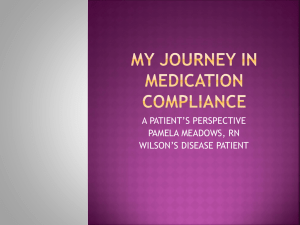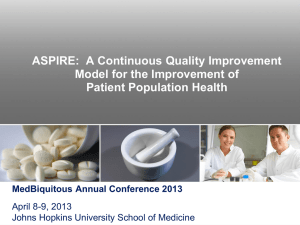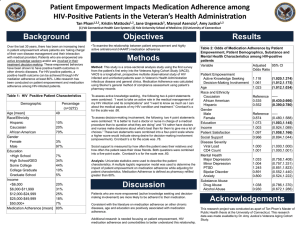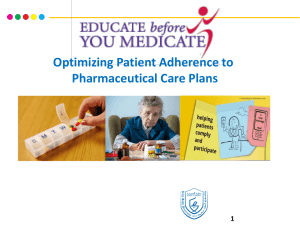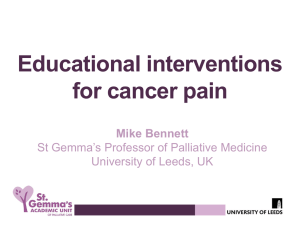Improving Adherence - Group for the Advancement of Psychiatry
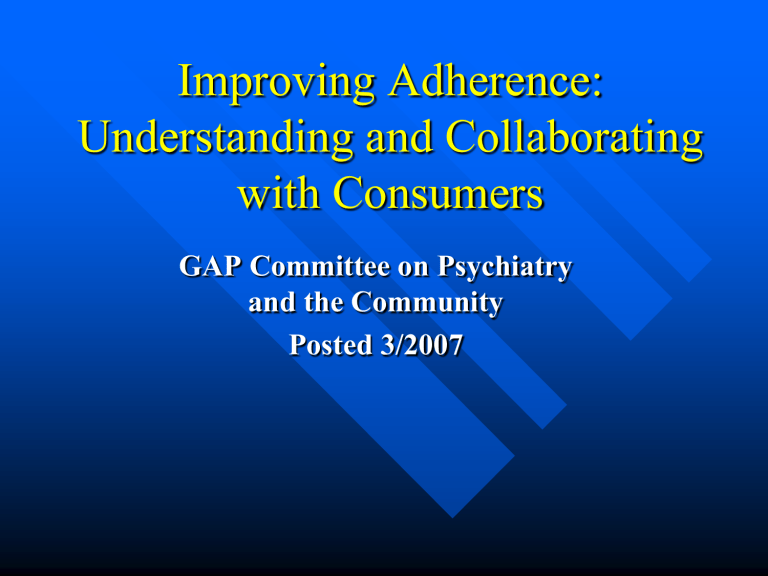
Improving Adherence:
Understanding and Collaborating with Consumers
GAP Committee on Psychiatry and the Community
Posted 3/2007
Improving Adherence:
Six suggestions for use of these materials
4.
Case example slide set: Each of the 45 cases (generally
4 slides per case) illustrates points associated with adherence. The case format is:
– Slide 1: Presenting problem
– Slide 2: Clinical intervention
–
Slide 3: Teaching points
– Slide 4: Classification of diagnoses and barriers
5.
Presenters are encouraged to select from the cases or to create case slides from their own experience.
6.
Cases are intended to be inserted in the didactic slide set at the presenter’s discretion.
“Pop Quiz”
What is the difference between efficacy and effectiveness?
How many of you think that patients are honest with you about how they take their meds as directed?
How many of you take the meds prescribed for
YOU as directed?
How many of you have heard more talks about receptors than you need to?
Adherence:
The Scope of the Problem
Pills don’t work if patients don’t take them.
Adherence:
The Scope of the Problem
“For the first three years that I was in treatment, I did not believe that I was ill, and tried not taking my medication. I felt oppressed by the judgment of my doctor.”
Adherence:
The Scope of the Problem
Non-adherence is the primary cause of treatment failure.
Adherence:
The Scope of the Problem
“ I’m getting better, not only because my new medication works, but also because I’m motivated to take it.”
Adherence:
The Scope of the Problem
Non-adherence is common and should be anticipated.
Adherence:
The Scope of the Problem
“Sometimes we need to be taken by the hand and walked through a simple decision just to learn how to discriminate what is good decision-making and what is bad.”
Perspectives on
Improving Adherence
•
Patient Focused: Biological
•
Relationship Focused
•
Patient Focused: Psychosocial
•
Therapeutic Interventions
•
Systems Interventions
Biologically Focused
Efficacy Does Not
Equal Effectiveness
Most data derive from efficacy studies, from patients who take meds as prescribed
Patients with complex diagnoses or comorbidities, and those on multiple meds, are rarely studied
“Real” patients seldom take meds as prescribed
Problems with ”data” we use
•
Usual studies: monotherapy in adherent, uncomplicated subjects who don’t drink or use drugs
• Studies are usually Lacking
• Dual Diagnoses
• Multiple meds used simultaneously
•
Naturalistic Follow Up
•
Instead, we use
• Local Uncontrolled “Groups”
• N=1 Studies (our own personal experiences)
Side Effects (SE) or
Therapeutic Effects?
Diphenhydramine
Insomnia
Effect-sedation, SE-dryness?
Rhinorrhea
Hives
Effect-dryness, SE-sedation
Effect-Antihistaminic
SE-sedation and dryness
The Acceptability Spectrum
•
Immediate, Desired Effect
•
Percodan, Valium
•
Intermediate Effect, No Side Effects
•
Antibiotics
•
Little Perceived Effect
•
Antihypertensives, Calcium
•
Delayed or Unwanted Effects, Side Effects
•
Antipsychotics, Antidepressants, Mood Stabilizers
Relationship Focused
The Relationship Drives the Solution
Regardless of the barriers to adherence, the therapeutic alliance is critical to the success of the treatment.
The Relationship Drives the Solution
“If my doctor believed in me, I took it on trust, and believed in my self.”
The Therapeutic Relationship
•
Your feelings about them
•
Their feelings about you
Continuum of Autonomy
Self-Care
Alliance
Persuasion
Coercion
Pressure
Time
Problematic Attitudes
• The patient is “treatment resistant.”
• The patient is “manipulative.”
• The patient “doesn’t want help.”
•
The patient refuses my help, so I’m not responsible.
• The patient doesn’t “deserve” help.
Helpful attitudes
“We’re in this together” (“us” versus your problems)
“What do YOU want help with?”
“I care about you whether you take my recommendations or not.”
“It’s OK for us to disagree.”
Assumptions That Undermine
Alliances
Patients never seem to know what’s best for them
I know best what the patient needs
Mental illness makes it impossible for patients to decide what’s best
The patient is almost always too ill to decide
It’s my role to advise the patient and to get them to follow that advice
The patient is too dangerous to be given choices
They’ve already shown that they can’t be trusted to do what’s best for themselves
Assumptions That Promote
Alliances
•
People should be allowed (and encouraged) to take control over their own lives.
•
People, including those with mental illness, do things to feel better.
• Patients’ perception of their reality is critical
Patients’ Concerns
•
Shame
-
“The doctor will be disappointed with me for not following his advice.”
•
Guilt
“I should be taking better care of myself.”
•
Fear
“She’s going to get angry if I tell her what I’m really doing.” “He’ll put me in the hospital.”
•
Avoidance
“I’m not going to do this anyway, so why argue about it?”
Patients’ Concerns
•
Time constraints
“All he wants to do is rush me out of here. I need to talk.”
•
Indifference
“The doctor doesn’t care about me anyway.”
•
Pride
“I know better than the doctor.”
•
Embarrassment
“She already explained that, so I better not ask again.”
Patient Focused: Psychosocial
Common Reasons for
Non-Adherence
Illness issues
• Denial:
• “I’m not sick.”
• Minimization:
• “It’s not that bad.”
• Resistance to Illness Role:
• “I don’t want to be sick.”
• Shock/Anxiety:
• “After learning my diagnosis, all I could hear was blah, blah, blah.”
• Cognitive/Memory difficulties:
• “I wonder what he told me to take.”
• Substance use:
• “I better not take these pills with the alcohol I’m drinking.”
• Depression:
• “I don’t care if I live or die.”
Common Reasons for
Non-Adherence
Treatment Issues
•
Logistics:
• “I forget my mid-day pills.”
•
Side Effects:
• “The cure is worse than the disease.”
•
Poor information
• “I thought I could stop once I felt better.”
Common Reasons for
Non-Adherence
•
Distrust of the prescriber:
• “The doctor is just a pill pusher.”
• “The doctor didn’t listen.”
• “No one’s going to tell me what to do.”
•
Distrust of the treatment:
• “It isn’t necessary.”
• “It won’t help.”
•
The side effects are worse than the illness
Common Reasons for
Non-Adherence
• Shame / Stigma
• “I’m not crazy.”
• “I don’t want to be seen getting/taking medication/treatment.”
• “I shouldn’t need this kind of help; I should do it on my own.”
•
Family / cultural / contextual issues
• “My family/culture/religion is against medication.”
• “My boss will find out.”
• “I’ll never get insurance after this.”
Therapeutic Interventions
Talking with Patients to Initiate
Adherence
Explore/respond to concerns/emotions
Build rapport
Educate the patient
Collaborate with the family
Negotiate solutions/review plans
Explore/Respond to Concerns
Let patient tell story
Elicit patient’s beliefs about illness/explanatory model
Elicit patient’s feelings about treatment
Keep questions open-ended
Build Rapport
Partnership: “Together, we…”
Respect: “I am impressed by…”
Support: “I am here to help…”
Reflection: “You seem…”
Legitimization: “I agree...”
Interactively Promote Patient
Education
Keep it short and focused...
“I think you have…”
Solicit patient’s understanding...
“What do you know about...?”
Give details after you learn about patient’s perceptions...
“Let me tell you more about…”
Check patient’s understanding
“How would YOU describe …?”
Collaborate with the Family
Ask patient’s permission to communicate with family/supports
Gather family’s perspective on what has helped in the past
Educate family about patient’s illness and proposed treatment
Support family’s coping with an ill relative
Negotiate Plans
Inquire
– “What do you think might help?
Suggest
– “This is what I think you should consider…
Compromise
– “Or, maybe we could start with…?”
Reaffirm
– “So, we agree on…”
Talking with Patients to Sustain
Adherence
•
Be honest about the realities
•
Facilitate openness
“I’d rather you tell me the truth than tell me what you think I want to hear.”
•
Present yourself as non-threatening but
“knowing the score”
Talking with Patients to Sustain
Adherence
• Be empathic
• “That must be frightening.”
•
Pick up on non-verbal cues.
• “You look upset with the plan.”
Talking with Patients to Sustain
Adherence
• Create a Partnership/Individualize the Plan
• “We’re a team here, even when we disagree. Both of us share the job of making your life better and happier”
• “Can you tolerate that side effect, or should we try a different medicine?”
• “People respond differently, so let’s see how this works for you.”
Talking with Patients to Sustain
Adherence
•
Accept the likelihood of non-adherence
• “How many pills did you skip after you noticed you were nauseated?”
• “Do you find yourself forgetting the midday dose?”
• “I guess you’re not sure you still need this treatment.”
Talking with Patients to Sustain
Adherence
• Invite questions
• “What worries you about this treatment?”
•
Express realistic optimism
• “You can’t concentrate right now, but I expect that to improve soon.”
• “You should find yourself getting along better with other people.”
Talking with Patients to Sustain
Adherence
•
Look for areas of agreement
• “Let’s agree to disagree on your diagnosis, but we seem to agree that you need more sleep.”
•
Encourage honesty
• “I’d rather KNOW what you’re actually taking than have you try to please me with your answer.”
Talking with Patients to Sustain
Adherence
•
Address stigma
• “These are biological illnesses, caused by chemical changes in the brain, much like diabetes is caused by changes in the chemistry of the body.”
•
Ask about hopes
• “What are your goals? How can we help you get there?”
Talking with Patients to Sustain
Adherence
• Provide educational material.
• “Here’s a fact sheet you can use as a reminder.”
• Engage patient in active learning
•
Involve the patient: e.g., drawing, roleplaying, use common examples.
• Repetition is necessary to reinforce learning.
Talking with Patients to Sustain
Adherence
•
Be clear and honest about follow-up plans.
“The clinic is rushed and busy, but the doctors there really care about their patients….”
•
Flexibly facilitate follow-up
“Why don’t we visit the program while you’re still here in the hospital, and you tell me if you’re comfortable with it.”
• Collaborate with other clinicians
“Let me call your family doctor and see how he thinks this med will work in combination with the meds he gives you.”
Talking with Patients to Sustain
Adherence
•
Mobilize support; encourage self-help and advocacy
“Do you have a friend or family member who might help you with this?”
“I know some folks with problems like yours. Do you think meeting with them might help?”
“You are an inspiration to others. Would you consider speaking at a conference and sharing your story?”
Talking with Patients to Sustain
Adherence
•
Address Logistical Issues
“Does your insurance cover the cost of this treatment?”
“You’ll be here for several hours. Do you need someone to watch your baby?”
•
Provide Continuity
“If you need immediate help, there’s always a team member available. Here’s the number to call.”
•
Be Available
“If the side effects are troublesome, call me and maybe we can adjust the dose.”
Aids to Treatment
Adherence
•
Call/write ahead to remind of upcoming appointment
•
To ease transition, introduce to future clinicians
•
Provide transportation and other logistical supports (e.g., childcare, note to employer)
Aids to Medication
Adherence
•
Select the simplest dosing regimen you can
•
Link dosage timing to daily routine, e.g. meals
•
Use pill boxes at home and on trips
•
Gain assistance from family members and other supports
•
Supervise medication administration
•
Consider long-acting and/or injectable meds
Management of Medication Side
Effects
• Educate about side effects before they happen.
• Ask regularly about side effects.
• Take any reported distress seriously.
• Involve patient’s social and health care supports.
Management of Medication Side
Effects
“I think many schizophrenics fall through the cracks of our system and do not develop their potential because the mental health system does not provide adequate information. This is a big issue to me. I believe that if I had been told in the hospital about the positive and negative effects the medication could have on me and about the doctor’s plan to eventually reduce my dosage, I would have been more receptive and cooperative.”
Preserving Treatment Alliance when
Coercion is Necessary
• Remember that coercion (e.g., involuntary admission, outpatient commitment, forced meds) need not undermine alliance
•
Consider the use of advance directives
•
Explain the purpose and nature of any involuntary interventions
•
Provide opportunities for patients and staff to debrief incidents
Preserving Treatment Alliance
When All Else Fails
•
Stay connected with patient.
•
Offer other services that the patient may accept.
•
Continue to offer medication as an option.
•
Share potential problems with the patient.
• Plan ahead for how you’ll respond.
Always Remember the Patient’s
Perspective
“We need to be told we are valuable human beings, lovable people with a capacity for love and giving of ourselves.”
“I am fortunate in that I discovered, regardless of whatever chemical imbalances are taking place on a physiological level, I still have power over my own choices in life.”
System Interventions:
Qualities of an Effective System
•
Capable
•
Comprehensive
•
Continuous
•
Accessible
•
Individualized
•
Flexible
•
Meaningful
End of Basic Slide Show
The slides that follow (#58-79) are available to be included in whatever ways user chooses to customize the presentation for a specific audience or purpose.
Assessing / Promoting Adherence
METHOD ADVANTAGES DISADVANTAGES
Patient self-report
Pharmacy reports / pill counts
Blood levels of medication
Directly observed therapy
Intramuscular longacting medication
Practical. Can enhance doctor-patient relationship
Objective information on whether pills are removed from bottle.
Objective information on whether medication is ingested
Maximum certainty the patient put pills in mouth
Certain and infrequent administration
Patients/providers overestimate adherence
Pills can be stored, shared, stored, taken off schedule
Covers a very short time frame/ can be manipulated
Can be infantilizing and expensive; patient can spit out/vomit up pills.
Side effects difficult to address; most medications unavailable
Psychiatric Medications are Intended to
Improve the Quality of Life.
•
Objective criteria
• Subjective criteria
• Balancing needs and wants
Pyramid Model of Side Effect
Burden
Side
Effect
A
Burden from A
Overall Burden
Side Effect B
Burden from B
Absolute burden = area of A or B Relative burden = area of A
area of B
Weiden PJ et al. J Clin Psychiatry.
1998;59(suppl 19):36-49.
Hierarchy of Side Effect Burden:
Conventional Antipsychotics
Other
•
•
•
Akathisia
Akinesia
Dysphoria
EPS
•
Dystonia
•
Rigidity
•
TD*
•
Tremor
EPS is the major burden from conventional antipsychotics
* TD = tardive dyskinesia
Weiden PJ et al. J Clin Psychiatry.
1998;59(suppl 19):36-49.
EPS Rates: Quetiapine vs
Haloperidol
Parkinsonism (Simpson-Angus Scale)
50%
*
40%
Percent of Patients
30%
20%
Placebo Quetiapine
10%
0%
* p < .05 vs placebo.
75 150 300
Dose (mg/d)
Arvanitis L, Miller BG. Biol Psychiatry.
1997;42:233-246.
600 750
Hal
12
Common Long-Term Side
Effects
EPS
Hal Ris Olan Quet Zip
+++ + / ++ – / + – / + – / +
Olan = olanzapine; Quet = quetiapine
Adapted from Casey D. J Clin Psychiatry.
1996;57(suppl 11):40-45.
Hierarchy of Side Effect Burden:
First-Line Atypical Antipsychotics
•
Akathisia
•
Akinesia
•
Dysphoria
Other
EPS
EPS burden is greatly reduced with first-line atypical antipsychotics
•
Dystonia
•
Rigidity
•
TD
•
Tremor
(cont)
Weiden PJ et al. J Clin Psychiatry.
1998;59(suppl 19):36-49.
Hierarchy of Side Effect Burden:
First-Line Atypical Antipsychotics
•
Amenorrhea
•
Anticholinergic
Other
•
Sedation
•
Sexual
•
Weight gain
EPS
Focus of concern is moving away from EPS. It is moving towards other, non-EPS, side effects
Weiden PJ et al. J Clin Psychiatry.
1998;59(suppl 19):36-49.
Common Long-Term Side Effects
Hal Ris Olan Quet Zip
EPS +++ +/++ –/+ –/+ –/+
Anticholinergic +/ – * – *
+ – –
Sedation
Prolactin
Weight gain
+/ – + +/++ +/++ +/ –
+++ +++ – – –
+ ++ +++ + –
* Not taking into account possibility of also receiving anticholinergic medications for
EPS.
Adapted from Casey D. J Clin Psychiatry.
1996;57(suppl 11):40-45.
Differences in Estimated Weight
Gain
Clozapine
Olanzapine
> Risperidone
Quetiapine
>
Ziprasidone
Allison DB et al . Am J Psychiatry.
1999. In press.
System Interventions: Capable
•
Overall Capacity to Provide What is
Needed.
System Interventions:
Comprehensive
•
Providing the Full Extent of Services,
Housing, “Hard Goods”, Supports, and
Social Activities Needed.
System Interventions:
Continuous
•
Providing for the Smooth Flow of
Patients and Information Between
Programs, People, and Needs.
System Interventions: Accessible
•
Available When and Where Patients
Are.
System Interventions:
Individualized
•
Able to Change Treatment Plans and
Interventions as Patients Do.
System Interventions: Flexible
•
System Equivalent of Individualized –
Changing to Meet Consumers’ Needs.
System Interventions:
Meaningful
•
Responsive to the Larger Framework of Consumers’ Lives and Interests.
Improving Compliance/Adherence
“There are problems with the entire concept of compliance”
- Ron Diamond
Medications and Life Goals
Many patients have difficult lives
They want to “get a life”
Relapse prevention doesn’t equal
“getting a life”
Patients may have trouble connecting taking medications with
“getting a life”
(cont)
Medications and Life Goals
What are your goals?
What has to happen for you to achieve your goals?
Newer medications are much more likely to help you “get a life”
Strategies for Enhancing Medication Use
In Persons with Long Term Mental Illness
•
Be assertive when necessary.
• Know what clinical and legal options are available.
•
Structure and supervision is often enough.
•
Use a wide range of incentives to encourage people to take medication.
•
Legal coercion may be necessary with some consumers for some period of time. To be effective, it requires a well developed treatment plan that includes all agencies involved.
Use of Long-Acting Injections
•
Some consumers prefer infrequent medications to daily pills.
•
Intramuscular injections may be more effective than oral medication for some people.
•
Medication monitoring is easier with long acting injections, but follow-up for missed injections is critical.

